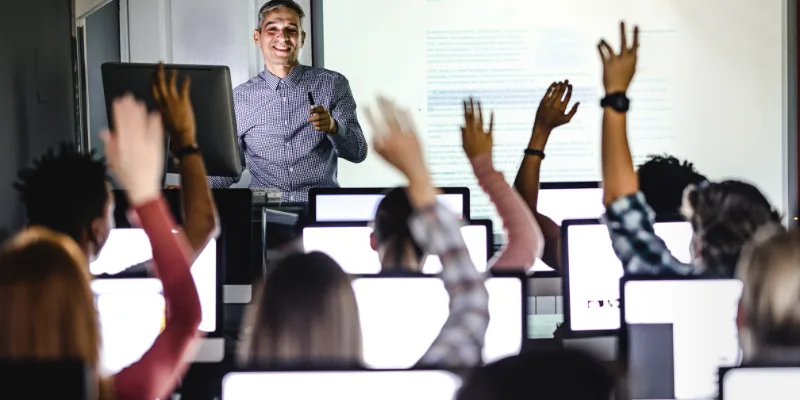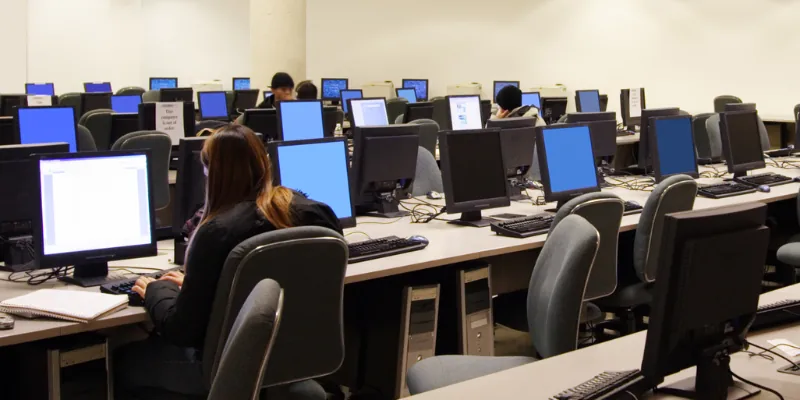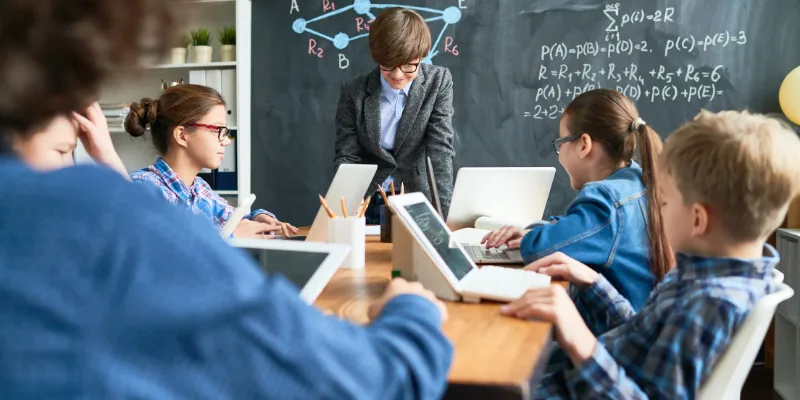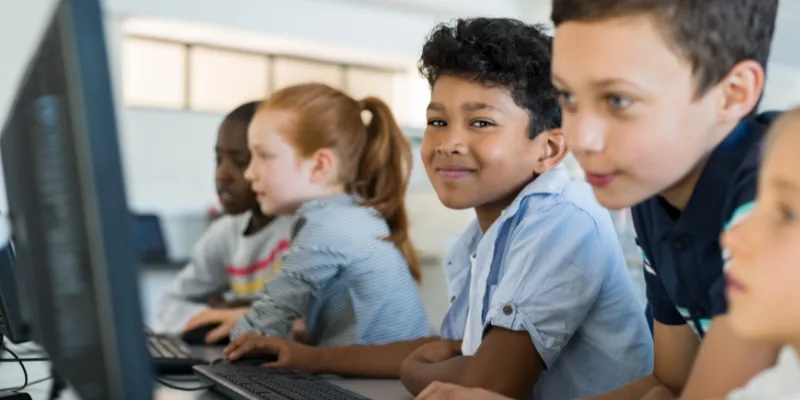Advantages of Computer in Education for Learning Growth
Published: 16 Feb 2025
Did you know that over 90% of schools worldwide now use computers for teaching? Education has changed dramatically over the past few decades, and technology plays a key role in this transformation. Today, students no longer rely only on textbooks and blackboards. Instead, they have access to digital learning tools, educational apps, and virtual classrooms. With just a few clicks, they can find answers to any question, watch video lessons, and even attend online classes from anywhere. Studies show that Students who use computers in learning often perform better and develop essential skills for the future. Let’s explore how computers are making learning smarter, easier, and more engaging. The key advantages of computer in education are following:
Access to Information
Computers make it easy for students to find information quickly. Instead of spending hours searching through books in a library, they can get what they need with just a few clicks. The internet provides unlimited resources that are available 24/7, allowing students to study anytime. Search engines like Google help them find quick answers, while websites and online databases offer valuable information. Students can also access digital books, articles, and academic papers without needing physical copies. Online libraries allow them to browse and borrow materials easily.
Learning is more engaging because information is available in different formats, such as text, videos, and audio. With computers, students can focus on relevant information without distractions and learn from experts worldwide. Research has become much simpler compared to traditional methods, and students no longer have to rely only on textbooks. Overall, computers make learning more convenient and efficient for students everywhere.

Interactive Learning
Learning becomes much more engaging with computers. Students are no longer limited to textbooks; they can use educational apps, games, and videos to make learning fun and interactive. This dynamic approach keeps students interested and helps them remember information better. Computers bring lessons to life with visual aids, animations, and interactive quizzes. Difficult topics become easier to understand when explained through videos and simulations. Instead of just reading about a subject, students can see and experience it in a more exciting way.
Interactive lessons allow students to practice new skills immediately, while quizzes and games provide feedback to track their progress. Virtual simulations help students understand complex topics like science or history by making them more realistic. Visual learning aids are especially helpful for students who struggle with traditional learning methods. With computers, students can explore topics at their own pace and dive deeper into subjects through various digital resources. This hands-on learning experience boosts motivation and makes studying more effective.

Faster Research
Computers make research and project work faster and easier for students. Instead of spending hours searching through physical books or archives, they can quickly find the information they need online. Websites and platforms like Google Scholar provide access to academic papers and peer-reviewed articles, making research more reliable. With just a few clicks, students can gather materials related to any topic without the need to visit a library in person. This saves time and allows them to focus more on understanding and organizing their work.
Digital tools help students manage their research better. Online citation tools make referencing easier and more accurate, while spreadsheets and calculators assist with data analysis. Students can also collaborate on projects using online platforms, making group work more efficient. They can create digital reports and presentations with images, charts, and animations, making their work more engaging. Overall, computers provide a convenient way for students to conduct research and complete projects efficiently.
Online Learning
Computers make online learning possible, which has become especially important during the pandemic. Virtual classrooms allow students to attend lessons from home, giving them the flexibility to learn at any time and from any place. If a student misses a class, they can access recorded lessons and review them as many times as needed. This makes learning more convenient and helps students understand topics better. Online courses also allow students to learn at their own pace, making education more personalized.
Virtual classrooms enable students to interact with teachers and classmates in real time, just like in a traditional classroom. Students in remote areas can attend top schools and universities online, breaking down geographical barriers. Online exams and digital assignment submissions make learning more efficient. Learning platforms provide extra resources and support beyond class hours. Students can also connect with peers worldwide, gaining a broader perspective. Computers make education more accessible and flexible for everyone.

Writing & Presentation
With computers, students can improve their writing and presentation skills easily. Word processors like Microsoft Word and Google Docs help them type, edit, and organize their ideas clearly. These tools also offer spell-check and grammar correction, allowing students to fix mistakes instantly. Formatting options make it simple to create well-structured documents. Instead of writing by hand, typing on a computer is faster and more efficient, helping students complete assignments quickly. Digital outlines help in organizing thoughts before writing, making the process smoother.
Presentation tools like PowerPoint allow students to create professional slides with text, images, videos, and animations. This makes their presentations more engaging and visually appealing. Digital presentations also help develop communication skills, as students can practice public speaking using slideshows. Computers make collaboration easier by allowing multiple students to work on the same document or presentation online. Overall, digital tools make writing and presenting more organized, creative, and effective.
Better Communication
Computers have made communication between students and teachers much easier. Instead of waiting for the next class, students can email or message teachers for quick help. Teachers can also provide feedback on assignments faster, allowing students to improve their work without delays. Important announcements and study materials can be shared online, making it easier for students to stay updated. Online communication tools ensure that learning continues even outside of class hours.
Students can ask questions in online forums or discussion boards, where both teachers and classmates can help. Virtual office hours give students more time to interact with teachers and get extra support. Teachers can also track students’ progress and provide personalized guidance. Real-time feedback keeps students on track and helps them understand lessons better. Even when students are absent, they can stay connected and catch up on missed work. Overall, computers make learning more interactive, accessible, and efficient for everyone.

Digital Skills
Using computers in education helps students develop important technical skills that are essential for today’s world. These digital skills are useful not only for future careers but also for everyday tasks. Students learn how to use software programs like Word, Excel, and Photoshop, which are common in many jobs. They also become more familiar with search engines and online tools, improving their digital literacy. Computers teach problem-solving as students figure out how to fix technical issues, which boosts their critical thinking abilities.
In addition, learning to use technology makes students more productive and prepares them for the tech-driven future. Students can explore fields like coding and programming, which are in high demand in the job market. These skills give students an advantage in their future careers. Computers also teach students how to use the internet safely and responsibly, ensuring they are ready for both academic and professional success.
Personalized Learning
Computers make personalized learning easier, allowing students to learn at their own pace. They can review lessons as many times as needed until they fully understand the material. If a student finds a topic difficult, they can slow down and focus more on that area without feeling rushed. This flexibility helps ensure that no student falls behind.
Students can access online tutorials to help with challenging topics, and they can skip ahead when they feel confident. Personalized learning helps students remember information better and allows them to focus on areas where they need more practice. Online courses adjust to the speed of each student, making learning more effective for different learning styles. Teachers can track progress and offer individual support when needed. Personalized learning tools boost students’ confidence and help them succeed by tailoring the learning experience to their needs.
Instant Feedback
Computers allow students to receive instant feedback, which is important for improvement. After completing quizzes or assignments, students can quickly see how they did and what they need to work on. This immediate feedback helps them understand their mistakes and correct them right away. Self-assessment tools also let students track their progress and check their understanding of the material.
By getting quick results, students can identify and fix mistakes immediately, which helps them improve faster. These tools encourage students to take responsibility for their own learning and stay motivated. Instant feedback promotes active learning, as students can adjust and improve right after completing a task. Feedback tools also provide specific suggestions on how to improve, helping students focus on areas where they need to grow. Overall, instant feedback and self-assessment build students’ confidence and keep them engaged in their learning process.

Global Resources
Computers connect students to educational resources from all over the world, expanding their learning opportunities. Students can access online courses from top universities, explore lectures and tutorials by experts, and read research papers from leading academic journals. This helps them learn from the best, even if those resources are not available locally. Computers also give students access to educational content that they might not find in their own country.
Through online workshops, students can learn new skills and connect with others in a global learning community. Online platforms allow students to discuss topics with people from different countries, gaining diverse ideas and perspectives. Educational content can also be customized to fit each student’s needs. Learning from international experts offers unique insights and helps students become well-rounded thinkers. Overall, computers help students broaden their knowledge and connect with a global community, making education more enriching and diverse.
No, computers can’t replace teachers. They are great tools for learning, but students still need guidance, explanations, and support from teachers. Computers and teachers work best when used together.
Not every student needs a computer, but having one can make learning easier. Computers provide access to information, online classes, and study tools. Even without a personal computer, students can use school or library computers.
Computers help by providing instant access to information, videos, and interactive lessons. They also make writing, researching, and organizing study materials much faster. This saves time and makes learning more effective.
Yes, computers can be distracting if students use them for games or social media instead of studying. Setting time limits and using educational apps can help. Parents and teachers should guide students on using computers wisely.
Some great websites include Khan Academy, BBC Bitesize, Coursera, and National Geographic Kids. These offer free lessons, quizzes, and videos on different subjects. Students can learn at their own pace.
Parents can encourage learning apps, set screen time rules, and check what their kids are doing online. They can also explore educational websites together. Making learning fun and balanced is key.
Not always! Some learning apps and programs work offline. However, an internet connection helps students access online courses, research materials, and educational videos.
Yes, many educational games and apps are designed for young kids. Simple activities like alphabet games, puzzles, and drawing apps can improve their learning skills. Parents should monitor screen time to keep it balanced.
Computers provide special tools like text-to-speech, voice recognition, and interactive learning programs. These help students with disabilities learn in a way that suits them. Technology makes education more inclusive for everyone.
A good balance is using computers for research, videos, and practice while still reading books and writing notes. Students should take breaks and avoid too much screen time. Learning in different ways keeps the brain active and engaged.
Conclusion
So guys, in this article, we’ve covered the advantages of computers in education in detail. Technology is changing learning, but are we using it wisely? Instead of just watching videos, use computers to gain knowledge and build skills. My recommendation? Challenge yourself to learn something new daily. Whether it’s reading, coding, or taking an online course, small steps matter. Drop your answer in the comments!

- Be Respectful
- Stay Relevant
- Stay Positive
- True Feedback
- Encourage Discussion
- Avoid Spamming
- No Fake News
- Don't Copy-Paste
- No Personal Attacks

- Be Respectful
- Stay Relevant
- Stay Positive
- True Feedback
- Encourage Discussion
- Avoid Spamming
- No Fake News
- Don't Copy-Paste
- No Personal Attacks
